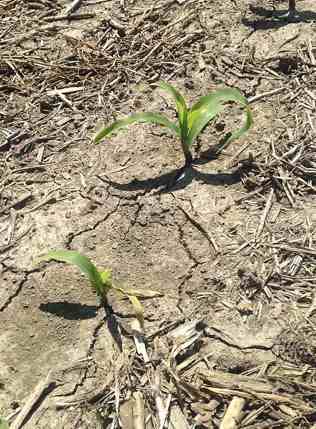By Angie Rieck-Hinz
As crops start to emerge, now is a good time to get out and do early-season scouting to see how things went with planting and to also check for any early season crop disease and insect issues. Knowing how things are looking can help you make more informed management decisions. Here are some tips and things to keep your eyes out for while doing early season scouting.
Tools
Before you head out to the field, there are several tools that are a must-have for early-season crop scouting. First, a tape measure to take stand counts. As the saying goes if you don’t measure it, you can’t improve it. Another important tool is a seed digger, trowel, or spade to dig up seeds or plants to evaluate planting depth, seedling diseases and below-ground feeding insects, like seed corn maggots. My personal preference is a square-bottom spade, you can easily push it into the ground a few inches from the furrow, pop open the furrow and look at planting depth, seed placement, sidewall compaction and rooting issues. A recent ICM News article “Crop Scouting Basics” outlined a thorough list of tools and resources for crop scouting.
Crop Diseases
The first principle of crop scouting is to determine what is normal and what is not normal. Knowing what a healthy plant looks like is key to identifying seedling diseases. Plants communicate in color and growth. When scouting for seedling diseases look for yellowing, wilted, stunted, dead or missing plants. In corn, look for discolored or rotten mesocotyls, seminal roots and nodal roots. In soybeans, look for seedlings that pull easily from the soil, discolored or rotting root tissue, and lesions that form on the taproot or hypocotyl.

While there may be nothing you can do to fix the problem this year besides replanting if necessary, scouting for seedling diseases can help you make management decisions for future years. Two resources that may be of help are IPM 76, A Farmer’s Guide to Corn Diseases (https://store.extension.iastate.edu/product/14600) and IPM 77, A Farmer’s Guide to Soybean Diseases (https://store.extension.iastate.edu/product/A-Farmers-Guide-to-Soybean-Diseases).
Favorable Conditions for Seedling Diseases
Generally speaking, certain weather and soil conditions favor specific pathogens. Cool and wet soils favor Fusarium and Pythium, warm and wet soils favor Phytophthora, and warm and moist soils favor Rhizoctonia. It should be noted that a lab diagnosis is needed to confirm what pathogen is actually causing the symptoms. Plant samples can be sent to the ISU Extension and Outreach Plant and Insect Diagnostic Clinic for confirmation. More information can be found at: https://hortnews.extension.iastate.edu/pidc.
Due to dry conditions during planting across most of Iowa this spring, we don’t anticipate seedling diseases to be a big issue, but you may find isolated pockets depending on soil drainage. Knowing what disease(s) is present can help you choose hybrids and varieties that have good disease scores in the future and can guide decisions on the use of fungicide treated seed.
Insects
Many insects can pose a potential threat to seedlings and small crops during the early growing season. For the purposes of this blog we will define “early growing season” from planting through the first week in June; however, in reality it has more to do with crop size or stage and degree days (thermal units) than an actual calendar date. Insect injury can cause stand loss and loss of leaf tissue (photosynthetic capacity); both of which can contribute to yield loss.